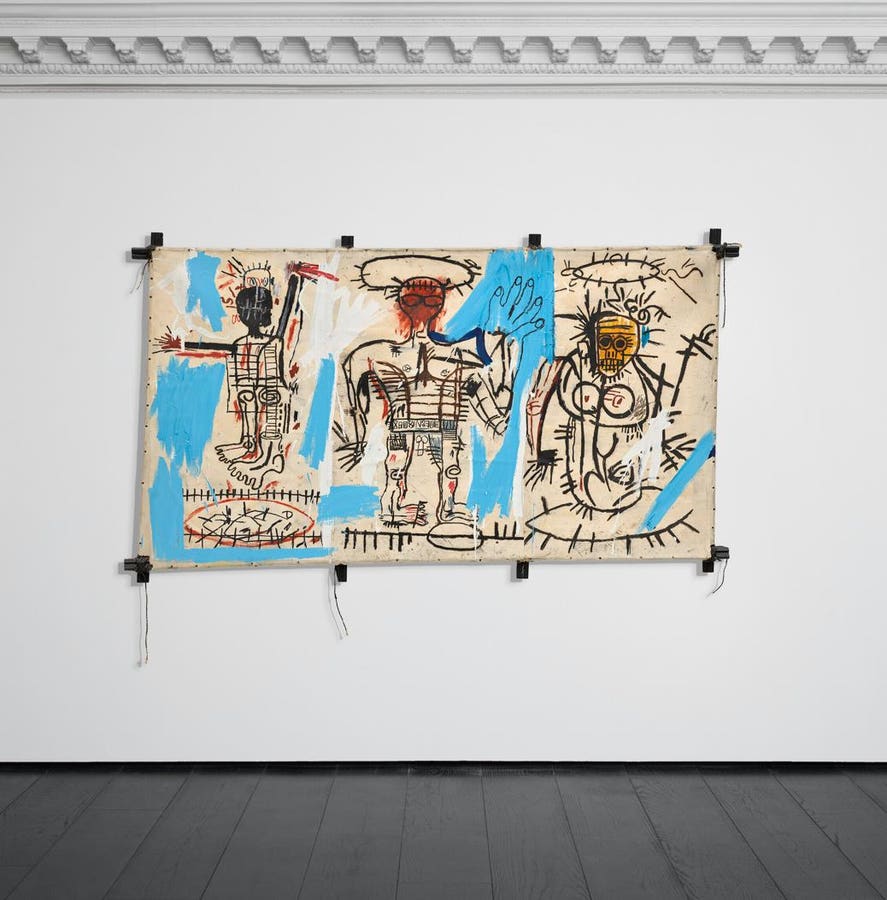JEAN-MICHEL BASQUIAT (1960-1988) Baby Boom acrylic, oilstick and paper collage on canvas mounted … More
Christrie’s New York
Three distinct figures sprawl across a seven-foot-wide, four-foot-tall landscape canvas, the man in the center and the woman on the right represent Jean-Michel Basquiat’s parents, Gerard and Matilda. The artist portrays himself on the left, in this deeply personal triple portrait, conveying the fraught yet devoted familial bonds with all three figures crowned by halos. Simple, heavy black lines form complex figures, with only their faces fully flooded with color. Matilda’s figure exudes femininity while Gerard’s stance is punctuated by an oversized raised hand, perhaps hinting at physical discipline. Serene blue acrylic patches, cradling the artist, accentuating the father’s magnified hand, and barely brushing by the mother’s leg, draw together the family unit.
Baby Boom (1982), an acrylic, oilstick, and paper collage on canvas mounted on tied wood supports, is expected to fetch between $20 million and $30 million when it leads the 21st Century Evening Sale on May 14 at Christie’s New York during the Spring Marquee Week. Myriad art historical and personal references abound, inviting rigorous contemplation of this masterpiece.
“From a historical standpoint, he’s really elevating the three figures. He’s adorned them with halos and crowns, and in this triptych format, it makes you think of altar pieces and the Renaissance. There’s also a very spiritual tone to this. Not only is it autobiographical, it also has layered art historical references. And it goes back to his inherent and stylistic choices that place him within history and the art historical canon more widely,” Isabella Lauria, head of the 21st Century Evening Sale, said in a phone interview. “It’s just beautifully rendered. It’s very intricate. Matilda’s face specifically alludes so much to the African tribal masks that we see in his work, and her body is like a fertility figure.”
Lines piercing the halos are reminiscent of the crown of thorns, a repeated symbol in art history representing the suffering and humiliation of Jesus Christ before his crucifixion, and they return the viewer’s gaze to the figures’ feet hovering above railroad track markings. The tracks below Basquiat and his mother are rounded, while his father stands over a single track disrupted by an oval right of center. Basquiat is balanced, or unbalanced, on two sets of tracks – one linear and consistent with carefully placed lines, the other line frenzied and emboldened with a red oval filled with frantic markings. A “D” in the upper right of the football-shaped red oval is distinct among the scribbles, and reminds the viewer of Basquiat’s Defacement, also known as The Death of Michael Stewart, painted on the wall of Keith Haring’s studio and referencing the New York City subway system’s D train. The D train is significant in Basquiat’s evolution as an artist, reminiscent of his early graffiti art under the alias SAMO, (a pseudonym for “Same Old Shit”) when he and Al Diaz tagged subway cars, particularly the D train, with pithy poems and aphorisms.
Railroad tracks are a recurring motif in Basquiat’s artwork, notably in Leonardo da Vinci’s Greatest Hits (1982), and may symbolize a literal and figurative journey, possibly alluding to slavery, exploitation, and the human body. They may represent a path guiding the viewer through Basquiat’s intricate imagery and symbolism and his artistic awakening, which was emotionally encouraged by his parents. The tracks may also imply drug use or a fear of being trapped in a cycle, and the ovals assigned to Basquiat and his mother may suggest their shared struggles with mental illness. Matilda nurtured Basquiat’s art appreciation at an early age, recognizing the gift of growing up in New York City with access to world-leading museums. Gerard was a complicated father figure, supporting his family financially, while fueling the artist’s rebellion and escape at age 17 from harsh parental discipline. Still, his father’s love endured, and Basquiat was keen for paternal approval.
Play Puzzles & Games on Forbes
“We have one really fantastic painting by the artist as an anchor, and we keep outdoing ourselves in that regard. This one is the most personal (Basquiat painting) I’ve had the pleasure to to work over the past few seasons, so I think that adds a very different layer to the narrative around the artist,” said Lauria.
Baby Boom was executed in 1982, Basquiat’s annus mirabilis, a treasure trove for elite global collectors vying for seven of his top 10 priced artworks. It was exhibited some 20 times, including its debut during Basquiat’s seminal 1982 solo exhibition at the legendary FUN Gallery, born out of the explosive East Village punk scene.
The title borrows from the post-World War II period (roughly 1946-1964, coinciding with Basquiat’s December 22, 1960, birth) in the U.S., when births surged after a relative decline during the Great Depression and the war years. Soldiers returning home, economic prosperity, and societal shifts gave rise to the bounce in births.
“The painting was acquired in 2001, and it’s been in the same collection for 24 years. I think what we’re seeing in the market is that excellent examples fetch very good prices and are endorsed at the end of the day. I think this is very fairly priced at $20 million to $30 million for the quality of the composition itself,” said Lauria. “ I think it really is about bringing to market excellent quality examples, and this is really one of them.”

